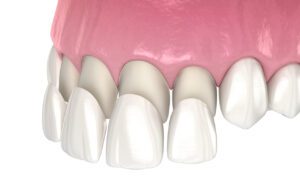
Dental veneers can be an easy, inexpensive approach to fixing teeth that are flawed. They can be an ideal choice to enhance the appearance of your front teeth by covering discolorations or imperfections. What exactly are veneers? They are a very thin shell that is bonded to the front of your teeth and is made either from ceramic (porcelain) or a composite resin material.
In many situations, a veneer can be a good alternative to getting a crown. They last for many years if properly applied, and are a more conservative method of changing the color, size or shape of a tooth.
What types of problems can a veneer help? They are best for fixing teeth that are worn down, chipped or broken; misaligned, uneven or irregularly shaped; and teeth with gaps between them.
How veneers are attached to your teeth
To have veneers attached to your teeth, your dentist may need up to three appointments to complete the procedure. This will include diagnosis and planning for the treatment, preparation of the veneer, and bonding it to your teeth.
The procedure begins by buffing half a millimeter of the teeth where the veneers will be attached. This allows the veneer to be attached without altering the profile of your tooth. You may require a local anesthetic during this part of the procedure. If you have a composite resin veneer, your dentist will bond and sculpt the composite material onto your teeth. This usually takes one appointment. For porcelain veneers, your dentist will take a mold of your teeth, and then send the mold to a lab that will make the porcelain veneer. This often takes several days and if you feel your teeth are unsightly while you wait, your dentist can attach a temporary veneer.
Once the porcelain veneers are ready to be placed on your teeth, your dentist will check for fit and the shade or color. Be sure to ask to view the veneers while they are resting on your teeth but before they are bonded. The color of the veneer can still be adjusted at this point by the cement’s shade that will be used to bond the veneer to your tooth. Once the cement is applied to the veneer and existing tooth, a special light beam is used to harden the cement and complete the bonding.
The advantages of veneers
What are the advantages of having dental veneers applied to your teeth? They are natural looking, your gum tissue will tolerate them well if they are porcelain veneers, and they are stain resistant (if they are made from porcelain). They often don’t require as much shaping as a crown but still offer a strong, aesthetically pleasing alternative.
The disadvantages of veneers
So what are the disadvantages? You can’t reverse the process, veneers generally can’t be repaired if they are cracked or chipped, and your tooth may become more sensitive to beverages and food that are hot or cold.
Finally, remember that veneers are not perfect replacements for natural teeth – they are facsimiles. For instance, you may see slight variations in the color of your veneers – although you’ll often see the same type of variations in natural teeth. But if you’re not happy with your current smile, veneers can be a viable way to improve your smile and increase your self-esteem.
Sources: Worldental.org, KnowYourTeeth.com, WebMD


